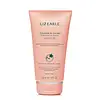What's inside
What's inside
 Key Ingredients
Key Ingredients

 Benefits
Benefits

 Concerns
Concerns

 Ingredients Side-by-side
Ingredients Side-by-side

Caprylic/Capric Triglyceride
MaskingGlycerin
HumectantWater
Skin ConditioningSafflower Seed Oil Polyglyceryl-4 Esters
CleansingSucrose Stearate
EmollientSucrose Laurate
EmollientSambucus Nigra Seed Oil
Butyrospermum Parkii Oil
EmollientPrunus Amygdalus Dulcis Oil
Skin ConditioningMalpighia Glabra Fruit Juice
Skin ConditioningTocopherol
AntioxidantZymomonas Ferment Extract
HumectantMel
EmollientMaltodextrin
AbsorbentLimonene
PerfumingLinalool
PerfumingGeraniol
PerfumingCitral
PerfumingCitronellol
PerfumingParfum
MaskingCaprylic/Capric Triglyceride, Glycerin, Water, Safflower Seed Oil Polyglyceryl-4 Esters, Sucrose Stearate, Sucrose Laurate, Sambucus Nigra Seed Oil, Butyrospermum Parkii Oil, Prunus Amygdalus Dulcis Oil, Malpighia Glabra Fruit Juice, Tocopherol, Zymomonas Ferment Extract, Mel, Maltodextrin, Limonene, Linalool, Geraniol, Citral, Citronellol, Parfum
Glycerin
HumectantPrunus Amygdalus Dulcis Oil
Skin ConditioningCaprylic/Capric Triglyceride
MaskingWater
Skin ConditioningSqualane
EmollientSucrose Laurate
EmollientCarapa Guaianensis Seed Oil
Skin ConditioningSucrose Stearate
EmollientBixa Orellana Seed Oil
EmollientCopaifera Officinalis Resin
MaskingMelaleuca Alternifolia Leaf Oil
AntioxidantTocopherol
AntioxidantHelianthus Annuus Seed Oil
EmollientCitrus Aurantium Dulcis Peel Oil
MaskingGlycine Soja Oil
EmollientSucrose Palmitate
EmollientGlycerin, Prunus Amygdalus Dulcis Oil, Caprylic/Capric Triglyceride, Water, Squalane, Sucrose Laurate, Carapa Guaianensis Seed Oil, Sucrose Stearate, Bixa Orellana Seed Oil, Copaifera Officinalis Resin, Melaleuca Alternifolia Leaf Oil, Tocopherol, Helianthus Annuus Seed Oil, Citrus Aurantium Dulcis Peel Oil, Glycine Soja Oil, Sucrose Palmitate
Ingredients Explained
These ingredients are found in both products.
Ingredients higher up in an ingredient list are typically present in a larger amount.
This ingredient is an emollient, solvent, and texture enhancer. It is considered a skin-softener by helping the skin prevent moisture loss.
It helps thicken a product's formula and makes it easier to spread by dissolving clumping compounds.
Caprylic Triglyceride is made by combining glycerin with coconut oil, forming a clear liquid.
While there is an assumption Caprylic Triglyceride can clog pores due to it being derived from coconut oil, there is no research supporting this.
Learn more about Caprylic/Capric TriglycerideGlycerin is already naturally found in your skin. It helps moisturize and protect your skin.
A study from 2016 found glycerin to be more effective as a humectant than AHAs and hyaluronic acid.
As a humectant, it helps the skin stay hydrated by pulling moisture to your skin. The low molecular weight of glycerin allows it to pull moisture into the deeper layers of your skin.
Hydrated skin improves your skin barrier; Your skin barrier helps protect against irritants and bacteria.
Glycerin has also been found to have antimicrobial and antiviral properties. Due to these properties, glycerin is often used in wound and burn treatments.
In cosmetics, glycerin is usually derived from plants such as soybean or palm. However, it can also be sourced from animals, such as tallow or animal fat.
This ingredient is organic, colorless, odorless, and non-toxic.
Glycerin is the name for this ingredient in American English. British English uses Glycerol/Glycerine.
Learn more about GlycerinPrunus Amygdalus Dulcis Oil comes from the sweet almond, a tree native to Iran. This oil has no fragrance and is non-volatile.
Almonds contain healthy fats, vitamins, and minerals. It is a rich source of Vitamin E, a great antioxidant and skin conditioning ingredient. Sweet almond oil contains fatty acids such as linolenic acid and triglycerides.
The content of sweet almond oil makes it a great emollient; it can help soften and hydrate your skin. Emollients create a barrier over your skin to trap moisture in. Sweet almond oil has antioxidant properties.
Those with an almond allergy should be careful of this ingredient and speak with a professional about using it in your skincare.
This ingredient may not be fungal-acne safe.
Learn more about Prunus Amygdalus Dulcis OilSucrose Laurate isn't fungal acne safe.
Sucrose Stearate is derived from stearic acid and sucrose (sugar). It is an emollient and emulsifier.
As an emulsifier, it prevents oils and water from separating in a product. This property also makes it a surfactant and therefore a cleansing agent.
Tocopherol (also known as Vitamin E) is a common antioxidant used to help protect the skin from free-radicals and strengthen the skin barrier. It's also fat soluble - this means our skin is great at absorbing it.
Vitamin E also helps keep your natural skin lipids healthy. Your lipid skin barrier naturally consists of lipids, ceramides, and fatty acids. Vitamin E offers extra protection for your skin’s lipid barrier, keeping your skin healthy and nourished.
Another benefit is a bit of UV protection. Vitamin E helps reduce the damage caused by UVB rays. (It should not replace your sunscreen). Combining it with Vitamin C can decrease sunburned cells and hyperpigmentation after UV exposure.
You might have noticed Vitamin E + C often paired together. This is because it is great at stabilizing Vitamin C. Using the two together helps increase the effectiveness of both ingredients.
There are often claims that Vitamin E can reduce/prevent scarring, but these claims haven't been confirmed by scientific research.
Learn more about TocopherolWater. It's the most common cosmetic ingredient of all. You'll usually see it at the top of ingredient lists, meaning that it makes up the largest part of the product.
So why is it so popular? Water most often acts as a solvent - this means that it helps dissolve other ingredients into the formulation.
You'll also recognize water as that liquid we all need to stay alive. If you see this, drink a glass of water. Stay hydrated!
Learn more about Water